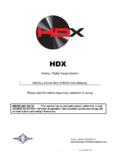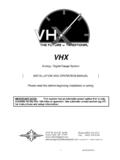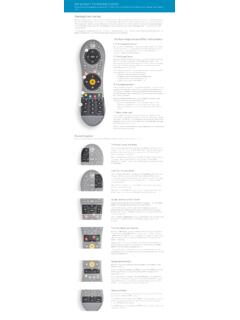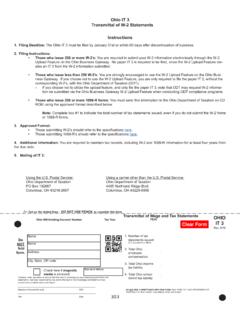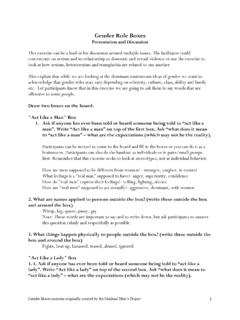Transcription of Anthropometry Procedures Manual - Centers for Disease ...
1 Anthropometry Procedures Manual January 2007 TABLE OF CONTENTS Chapter Page 1 OVERVIEW OF Anthropometry .. 1-1 Background of Anthropometric 1-1 Purpose of Anthropometrics .. 1-1 Importance of Anthropometric 1-2 Overview of NHANES Anthropometry Examination .. 1-4 Role of Anthropometric Examiner and Recorder .. 1-4 2 EQUIPMENT .. 2-1 Description of the Body Measurement Room in the 2-1 Equipment and Supplies .. 2-1 Equipment .. 2-1 2-6 Setup 2-9 Calibration Weights .. 2-9 Digital Weight Scale .. 2-10 Portable 2-10 Sitting Box .. 2-10 Stadiometer .. 2-10 Infantometer .. 2-11 Skinfold Caliper .. 2-11 Knee 2-11 Measurement Tapes and 2-12 2-12 Equipment Care and 2-12 Equipment 2-13 Packup 2-14 Calibration Weights.
2 2-14 Digital Weight Scale .. 2-14 Portable 2-15 Sitting Box .. 2-15 Stadiometer .. 2-15 Infantometer .. 2-15 Skinfold Caliper .. 2-16 Knee 2-16 Measurement Tapes and 2-16 2-16 iii TABLE OF CONTENTS (continued) Chapter Page 3 EXAMINATION 3-1 Eligibility 3-1 Pre-examination Procedures .. 3-1 General Guidelines for Measuring and Recording .. 3-2 Examination Procedures .. 3-3 3-3 Recumbent Length .. 3-5 Head 3-6 Standing 3-7 Upper Leg Length .. 3-10 Upper Arm Length.
3 3-12 Arm 3-15 Abdominal (Waist) Circumference .. 3-15 Skinfolds .. 3-17 Special 3-23 SPs in Street Clothes .. 3-23 3-24 SPs in 3-24 Amputees .. 3-25 Comprehension or Language Difficulties .. 3-25 Post-examination 3-26 4 ISIS DATA 4-1 General Screen 4-1 Weight 4-3 Weight 4-5 Tare and 4-6 Stature Screen .. 4-7 Height 4-10 Stature Comments .. 4-10 Sitting Measures 4-13 Upper Arm Length 4-14 iv TABLE OF CONTENTS (continued) Chapter Page Circumference Measures Screen .. 4-15 Skinfold Measures Screen .. 4-16 SP Information 4-17 Amputations 4-18 Anthropometry Component Status 4-20 5 QUALITY 5-1 Introduction to Quality control for Anthropometry .
4 5-1 Equipment Calibrations .. 5-1 Digital Weight Scale .. 5-4 Portable Scales .. 5-9 Stadiometer .. 5-10 Infantometer .. 5-12 Skinfold 5-14 Equipment Swap .. 5-15 ISIS Examination Screens .. 5-17 Observations, Replication, and 5-17 6 SAFETY Procedures .. 6-1 Equipment Precautions .. 6-1 SP Movement and 6-1 Emergency Procedures .. 6-2 List of Appendixes Appendix A Body Measures Recording Form .. A-1 B Procedures for Conducting Anthropometry Gold Standard Replicate Examinations .. B-1 v TABLE OF CONTENTS (continued) List of Tables Table Page 3-1 Body measurements by age 3-1 5-1 Anthropometry equipment calibrations .. 5-2 List of Exhibits Exhibit 2-1 Calibration weight (10kg).
5 2-4 2-2 Digital weight scale 2-4 2-3 Digital weight scale 2-4 2-4 Digital scale measurement 2-4 2-5 Portable scale .. 2-5 2-6 Sitting 2-5 2-7 Stadiometer headpiece and digital measurement 2-5 2-8 Stadiometer calibration 2-5 2-9 2-6 2-10 Calipers, step wedge, tape measure, 2-6 2-11 Anthropometry supplies (1) .. 2-8 2-12 Anthropometry supplies (2) .. 2-8 2-13 Anthropometry supplies (3) .. 2-9 3-1 Head circumference tape 3-7 3-2 Standing height position.
6 3-9 3-3 Upper leg length measurement position .. 3-11 vi TABLE OF CONTENTS (continued) List of Exhibits (continued) Exhibit Page 3-4 Marking spine extending from acromion 3-13 3-5 Correct tape placement for upper arm 3-13 3-6 Incorrect tape placement for upper arm length .. 3-13 3-7 Marking upper arm length 3-13 3-8 SP position for upper arm length and midpoint .. 3-14 3-9 Abdominal (waist) circumference mark .. 3-16 3-10 Measuring tape position for abdominal (waist) 3-16 3-11 Correct skinfold measurement .. 3-17 3-12 Incorrect skinfold 3-18 3-13 Triceps skinfold measurement .. 3-20 3-14 Location of subscapular 3-22 3-15 Subscapular skinfold 3-22 3-16 Subscapular skinfold 3-22 4-1 Logon SP screen .. 4-1 4-2 ISIS screen characteristics .. 4-2 4-3 Edit check box.
7 4-3 4-4 Weight screen .. 4-4 4-5 Weight screen lb kg warning 4-5 4-6 Weight screen comments list .. 4-6 4-7a Stature screen SPs 0-6 4-8 vii TABLE OF CONTENTS (continued) List of Exhibits (continued) Exhibit Page 4-7b Stature screen SPs 7-23 4-8 4-7c Stature screen SPs 4-9 4-7d Stature screen SPs 4yrs+.. 4-9 4-8a Stature screen Recumbent length blank 4-11 4-8b Stature screen Standing height value 4-12 4-9 Sitting measures 4-13 4-10 Upper arm length screen .. 4-14 4-11 Circumference measures 4-15 4-12 Skinfold measures 4-16 4-13 SP information 4-17 4-14 Amputations 4-19 4-15 Anthropometry component status screen - 4-21 4-16 Anthropometry component status screen - partial.
8 4-21 5-1 Body measures quality control 5-2 5-2 Digital weight scale full 5-4 5-3 Digital weight scale daily calibration .. 5-5 5-4 Digital scale display device .. 5-6 5-5 Digital weight scale full calibration scale set to lb .. 5-7 5-6 Digital weight scale daily calibration scale set to 5-7 5-7 Digital weight scale full calibration lb setting error 5-8 viii TABLE OF CONTENTS (continued) List of Exhibits (continued) Exhibit Page 5-8 Digital weight scale daily calibration lb setting error 5-8 5-9 Portable scales 5-9 5-10 Stadiometer calibration: In 5-11 5-11 Stadiometer calibration: Out of calibration 5-11 5-12 Infantometer calibration: In calibration .. 5-13 5-13 Infantometer calibration: Out of calibration recalibrated .. 5-13 5-14 Skinfold caliper 5-15 5-15 Equipment swap 5-16 5-16 Equipment swap skinfold caliper 5-16 ix 1.
9 OVERVIEW OF Anthropometry Background of Anthropometric Measurements Anthropometry is the study of the measurement of the human body in terms of the dimensions of bone, muscle, and adipose (fat) tissue. The word Anthropometry is derived from the Greek word anthropo meaning human and the Greek word metron meaning measure (Ulajaszek, 1994). The field of Anthropometry encompasses a variety of human body measurements. Weight, stature (standing height), recumbent length, skinfold thicknesses, circumferences (head, waist, limb, etc.), limb lengths, and breadths (shoulder, wrist, etc.) are examples of anthropometric measures. Several indexes and ratios can be derived from anthropometric measurements. Perhaps the most well-known indicator of body fatness is the body mass index or BMI.
10 BMI values are calculated for NHANES participants using measured height and weight values as follows: weight (kilograms)/height (meters2). BMI criteria are used to screen for weight categories: underweight (BMI values < ), normal or desirable weight (BMI values ), overweight (BMI values ), obese-Class I (BMI values ), obese-Class II (BMI values ) and extremely obese (BMI values > ) (National Institutes of Health, 1998). NHANES BMI results are used to track weight trends in the population. The National Institutes of Health, Centers for Disease control and prevention (CDC), and many other research groups have reported on the health risks associated with overweight and obesity using NHANES interview and health examination data. Purpose of Anthropometrics The purpose of the NHANES Anthropometry component is to collect high quality body measurement data using standardized examination Procedures and calibrated equipment.










